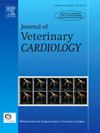10只犬静脉窦房间隔缺损伴部分肺静脉连接异常的临床特点、超声心动图表现及计算机断层血管造影诊断
IF 1.3
2区 农林科学
Q2 VETERINARY SCIENCES
引用次数: 0
摘要
简介/目的静脉窦房间隔缺损(SVASDs)通常与部分肺静脉连接异常(PAPVCs)相关,计算机断层扫描(CT)血管造影提供了较高的诊断准确性。然而,SVASD合并PAPVC仅在少数兽医病例中报道。本研究评估了CT对SVASD和PAPVC的明确诊断,并描述了SVASD和PAPVC犬的临床和超声心动图特征。动物、材料和方法回顾性分析10只经CT血管造影诊断为SVASD的犬。经胸超声心动图进行初步评估,CT血管造影证实诊断。描述了临床特点和超声心动图的表现。结果经胸超声心动图示右心房和心室扩张,7例疑似SVASD。其余3只犬,超声心动图未检测到SVASD。在每个病例中,计算机断层血管造影发现在颅腔静脉附近的房间隔有一个缺陷。所有犬均证实部分肺静脉连接异常,引流部位累及右心房、与颅腔静脉的连接处或颅腔静脉。9只狗接受了手术修复,1只狗因疑似严重肺动脉高压而不建议手术。研究局限性:病例数量少限制了统计评价,回顾性设计可能会在超声心动图评估中引入偏倚。结论犬静脉窦性房间隔缺损常伴有静脉窦性房间隔缺损,本组犬100%存在静脉窦性房间隔缺损。计算机断层扫描被证明是一种有价值的诊断工具,提高了识别SVASD和PAPVC的敏感性。本文章由计算机程序翻译,如有差异,请以英文原文为准。
Clinical characteristics, echocardiographic findings, and computed tomography angiography in the diagnosis of sinus venosus atrial septal defect with partial anomalous pulmonary venous connection in 10 dogs
Introduction/Objectives
Sinus venosus atrial septal defects (SVASDs) are frequently associated with partial anomalous pulmonary venous connections (PAPVCs) in humans, and computed tomography (CT) angiography provides high diagnostic accuracy. However, SVASD with PAPVC has been reported in only a few veterinary cases. This study evaluated CT for a definitive diagnosis and described the clinical and echocardiographic characteristics of dogs with SVASD and PAPVC.
Animals, Materials and Methods
Ten dogs diagnosed with SVASD using CT angiography were retrospectively reviewed. Transthoracic echocardiography was used for the initial assessment, and CT angiography confirmed the diagnosis. The clinical characteristics and echocardiographic findings were described.
Results
Transthoracic echocardiography revealed right atrial and ventricular dilation in each dog, with suspected SVASD in seven cases. In the remaining three dogs, echocardiography did not detect the SVASD. Computed tomography angiography identified a defect in the interatrial septum near the cranial vena cava in each case. Partial anomalous pulmonary venous connection was confirmed in all dogs, with drainage sites involving the right atrium, the junction with cranial vena cava, or the cranial vena cava. Nine dogs underwent surgical repair, and surgery was not recommended for one dog because of suspected severe pulmonary hypertension.
Study Limitations
The small number of cases limited statistical evaluation, and the retrospective design may have introduced bias in echocardiographic assessment.
Conclusions
Sinus venosus atrial septal defect in dogs is often accompanied by PAPVC, which was present in 100% of the cases in this group of dogs. Computed tomography proved to be a valuable diagnostic tool, enhancing the sensitivity of identifying SVASD and PAPVC in dogs.
求助全文
通过发布文献求助,成功后即可免费获取论文全文。
去求助
来源期刊

Journal of Veterinary Cardiology
VETERINARY SCIENCES-
CiteScore
2.50
自引率
25.00%
发文量
66
审稿时长
154 days
期刊介绍:
The mission of the Journal of Veterinary Cardiology is to publish peer-reviewed reports of the highest quality that promote greater understanding of cardiovascular disease, and enhance the health and well being of animals and humans. The Journal of Veterinary Cardiology publishes original contributions involving research and clinical practice that include prospective and retrospective studies, clinical trials, epidemiology, observational studies, and advances in applied and basic research.
The Journal invites submission of original manuscripts. Specific content areas of interest include heart failure, arrhythmias, congenital heart disease, cardiovascular medicine, surgery, hypertension, health outcomes research, diagnostic imaging, interventional techniques, genetics, molecular cardiology, and cardiovascular pathology, pharmacology, and toxicology.
 求助内容:
求助内容: 应助结果提醒方式:
应助结果提醒方式:


